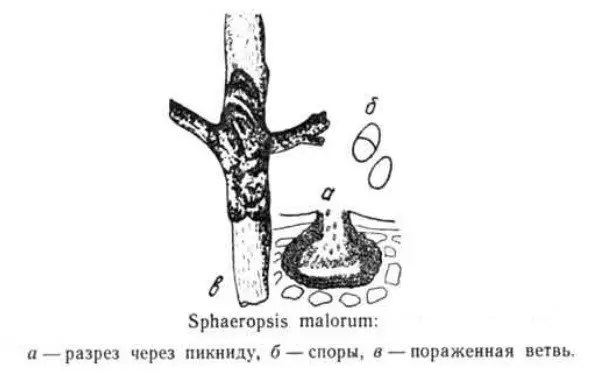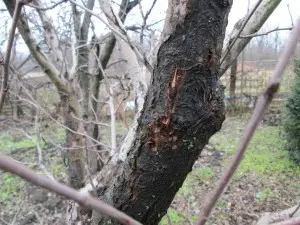Recently, gardeners have increasingly begun to notice a disease such as black cancer on their fruit trees. Most often, this disease affects apple trees (pears are in second place). Apple tree cancer can affect large garden areas. Black cancer of the apple tree is considered as a dangerous disease that can seriously damage fruit trees, up to their death.
What is black cancer?
Black cancer of the apple tree or “Anton fire” is a dangerous fungal disease that has an almost universal distribution. This disease is especially common in the southern, northern and central regions (most often found in the southern regions). Also, black cancer is often diagnosed in areas where sharp fluctuations in air temperature often occur, especially in autumn.
It is believed that this apple tree cancer affects weakened trees and faulty agricultural practices, damage by various pests and diseases (especially stem diseases), as well as the presence of frost and sunburn, lead to its development. But when a healthy apple tree is infected, there is a possibility of self-healing.
Quite often, this disease affects fruit trees that grow on heavy loamy soils where there is excess moisture. Outbreaks of black cancer are observed after a plentiful fruitful year.
The causative agent that causes this disease is the fungus Sphaeropsis malorum. The fungus reproduces by spores that are released by pycnidia during wet weather. The spores disperse and fall on healthy areas of the tree, infecting it. Infection of an apple tree occurs in the temperature range from +3 to +40, and the most favorable temperature for infection of a tree is +22 – + 28. It is under these conditions that the spores of the fungus germinate after about 6 hours. At lower temperatures, the spore is required to grow up to a day. The spores can remain on the tree for up to two years.
This type of fungus can infect fruits, leaves, trunk bark, as well as skeletal branches. A photo showing this fungus is shown below.

Of all the possible lesions, the most dangerous is the infection of the bark of a tree. In this case, the apple trees begin to bear fruit poorly.
Trees affected by this disease look as if charred. It is because of the appearance that black cancer got its second name – “Antonov’s fire.” A large number of affected areas on the bark and skeletal leaves leads to rapid drying of the leaves and indicates the imminent death of the apple tree. The death of a fruit tree, if nothing is done and it is not treated, occurs within a couple of years (approximately 3-4 years).
The disease has a virtually asymptomatic onset. Later, the following symptoms of the disease appear on the tree:
- rounded brownish depressions in the form of spots are formed on the bark, which practically do not attract attention to themselves;
- in the future, a sooty black coating forms in place of these spots;
- after a short period of time (can be very short), the affected area begins to “char”;
- healthy bark, as a result of increased tissue growth, rises along the edges of the spot;
- a gap is formed on the border between the diseased and healthy cortex, which leads to the formation of cracks;
- cracks are located in areas surrounding the site of the disease;
- in the future, large cracks form on the bark, as a result, it exfoliates and the wood is exposed;
- bare wood begins to blacken quickly;
- over time, the condition of the bark of the apple tree worsens.
Sawing off damaged branches gives only a temporary improvement and most often ends up uprooting the fruit tree.
In the photo below you can see how apple trees affected by black cancer look.

With the defeat of flowers, leaves and fruits, similar symptoms are observed as with infection of the bark. The course of the disease is best seen on the leaves.
Symptoms of black apple cancer on the leaves:
- reddish or brownish-brown spots appear on the foliage;
- they form after bud break;
- at the beginning of the disease, the spots are small and scattered over the entire surface of the leaf;
- spots, reaching a size of 6 mm, begin to turn brown;
- the spot may look like a blade;
- a gray part forms in the center of the spot;
- the stain begins to blur;
- the gray part of the spot even fills the space between leaf veins;
- then new spots appear;
- the spots seem to emerge one from the other;
- the disease affects the entire leaf blade.
As a result, premature drying of the leaf occurs, and it falls off. Leaf fall begins two months before fruit ripening. After it, there is a noticeable decrease in the quality of the fruit.
The disease of the fetus also has a similar picture:
- damage to fruits occurs before they ripen;
- dark subcutaneous spots form on the fruits;
- the lesion spreads from the site of damage by insects;
- spots quickly spread over the entire surface of the apple;
- then there is a darkening of the pulp;
- the fruit becomes wrinkled and dries out rather quickly;
- on apples, black cancer takes the form of black rot.
A distinctive feature of the development of infection on the fruit is the color of the spots (brown or dull black) and a noticeable roughness. This is clearly seen in the photo below.

Also, cancer affects the ovaries and unripe fruits, even those that are in storage.
Flowers that are affected by the fungus look like those burned by fire. Their petals turn brown and begin to curl. Pistil and stamen turn black.
It is known that the causative agent of black cancer of the apple tree can survive the winter, hibernating in its bark, as well as in other infected areas. If you suspect this disease, you can use a magnifying glass to examine the tree. If there is a fungus on the apple tree, then small dots that are located around the sores will be clearly visible in the magnifying glass. These spots are called pycnidia. In them, spores of the pathogen (pathogenic fungus) mature. The laying of pycnidia occurs under the upper skin. It ruptures at the moment of spore maturation. It is the presence of pycnidia that is an accurate sign of black cancer.
Video “Black cancer of fruit trees”
You can learn more about this infection in this video.
How to prevent
In order to prevent infection of the apple tree with this dangerous disease, preventive measures should be taken. Measures to combat this disease include the following:
- in autumn and spring, it is necessary to carefully clean the bark from fruit trees with iron brushes;
- all the dust that has formed after cleaning the bark must be burned;
- timely carry out all the necessary sanitary and preventive measures, which include pruning trees, tying young apple trees, pest control through collective processing and spraying with biological products, cutting dry and diseased branches;
- in addition to pest control, do not forget about carrying out preventive procedures to avoid infection of the apple tree with other diseases;
- monitor the correct care;
- carry out intensive weed control throughout the season;
- prevention of frost and sunburn, as well as cracks in the bark. To do this, whitewash the boles, as well as the bases of the skeletal branches on the apple tree.
In order to carry out correctly all preventive procedures, you must first know about all the necessary measures and prepare for them in advance.
You can also plant varieties of apple trees in your garden in advance that have increased resistance to this disease: Cinnamon striped, Borovinka, Pepin saffron and Papirovka.
One simple rule should be remembered – in order for your garden to produce a high-quality and large-scale crop, preventive measures are required, since it is much easier to prevent a disease than to cure it.
How to cure
However, preventive measures are not a panacea, they do not give a XNUMX% result, and an apple tree can still become infected with this dangerous disease. In this situation, it is necessary to properly treat the tree in order to most effectively and completely defeat this disease. Therefore, the question naturally arises: how to properly treat an already infected tree?
In order to treat black apple cancer, you need to do the following procedures:
- treatment must begin with the gentle removal of the bark and branches that are heavily affected by cancer;
- all resulting wounds and wounds must be lubricated with drying oil or oil paint based on it. Also, wounds can be treated with garden pitch, pharmaceutical green paint or paint. This process is shown in the photo below;

- then you need to start treating the remaining, undamaged part of the tree. the affected fragments are cleaned;
- disinfection is carried out with a solution of copper sulphate. Other drugs are also suitable, but they must contain copper in their composition;
- as a disinfectant, without stripping the wood, you can use a strong solution of potassium permanganate. They need to thoroughly wash the entire trunk and branches;
- also for disinfection, you can use a saturated solution with table salt, to which a couple of drops of iodine are first added;
- sometimes you can find information that ordinary washing powder was also used as a disinfectant;
- experienced gardeners suggest, after stripping, treating the tree with physiological putty, which is prepared from fresh mullein and clay in a 1: 1 ratio;
- leaves affected by cancer after flowering are treated with Bordeaux mixture;
- affected branches, bark and leaves are destroyed. They are collected and burned.
The process of treating infected apple trees is clearly visible in the video posted above.
Black cancer is a dangerous disease for the apple tree, neglecting prevention and treatment is fraught with the loss of the whole tree, which could grow and produce good yields for a long time. The process of treating black cancer of an apple tree requires a responsible and careful approach.









